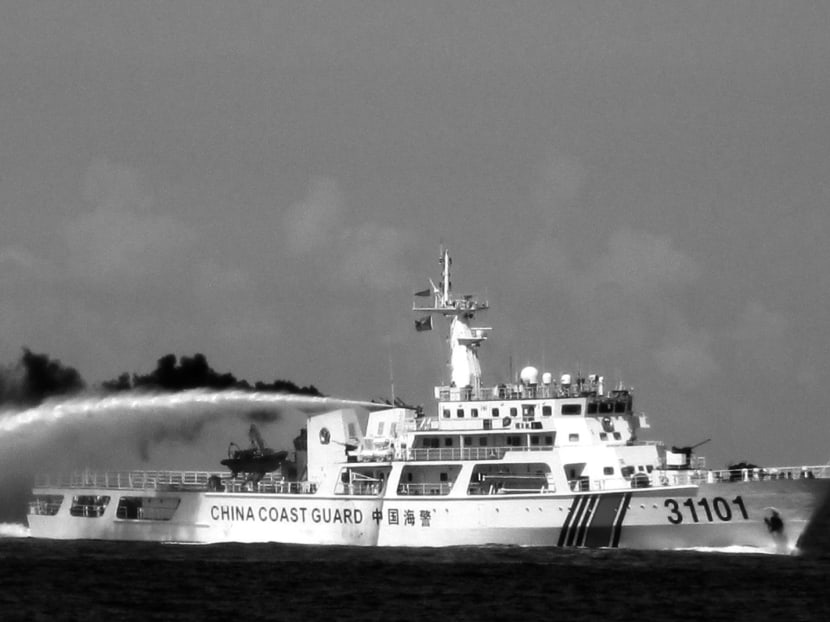ASEAN must take action amid tensions
Asians are now awake to the fear of armed conflict. A recent Pew Research Center survey of 11 Asian countries reported that more than half of those surveyed expressed concerns that tensions over rocks and islets claimed by China could spill over. In countries that have conflicting claims with China — Japan, the Philippines and Vietnam — 80 or even 90 per cent share such fears.

A Chinese coast guard vessel firing a water cannon at a Vietnamese vessel off the coast of Vietnam in May during a dispute over a deep-sea rig in the South China Sea. China’s decision to move the oil rig this month was a positive step. Photo: AP
Asians are now awake to the fear of armed conflict. A recent Pew Research Center survey of 11 Asian countries reported that more than half of those surveyed expressed concerns that tensions over rocks and islets claimed by China could spill over. In countries that have conflicting claims with China — Japan, the Philippines and Vietnam — 80 or even 90 per cent share such fears.
Steps must be taken to de-escalate tensions or the stability and growth of the region will be impacted. The high-level strategic discussion between the United States and China, hosted in Beijing, was one notable effort. Another recent and positive step was taken by China to move the oil rig it had earlier controversially placed in seas where its claims are challenged by Vietnam.
Other measures could come from emphasising the economic interdependence among the Association of Southeast Asian Nations (ASEAN), Japan and China.
One key area would be the creation of an ASEAN Economic Community by next year. It is estimated that about 80 per cent of the planned steps have been achieved as of August last year, but what is unsaid is that the remaining tasks are probably the most difficult to accomplish.
HOW ASEAN CAN INTEGRATE
Economic integration is neither going to be complete nor on time. Privately, ASEAN officials are now talking about next year being a milestone and not a deadline and have begun to identify an agenda beyond that date.
What is even clearer is that integration efforts depend not only on the 10 member states and the relatively small ASEAN Secretariat, but also on China and Japan.
The two largest Asian economies are stepping up their efforts to economically engage ASEAN. This could be helpful. But given the tensions — between China and Japan, as well as between China and some ASEAN member states — it could also be tricky.
Infrastructure to link ASEAN members is a clear need. Yet ASEAN’s own infrastructure fund has targeted a relatively modest US$13 billion (S$16.1 billion), with an initial capital of US$485.2 million.
China shows considerably more ambition, with a pledge of US$100 billion to kick-start an infrastructure investment bank to finance projects in ASEAN.
One pending infrastructure project that can gain from this fund is a railway link stretching from Kunming in south-west China to Singapore. Currently, about 90 per cent of the necessary rail connections remain unfinished and there is a need to finance and speed up work.
Another area is investment. While Beijing is ASEAN’s largest trading partner, Chinese investments into the region remain small, at only about 7 per cent of what the country sends overseas.
However, these look set to rise given China’s reform of its state-owned enterprises, rising labour costs, increasingly liberal approaches to cross-border trade and investment, as well as the gradual internationalisation of the yuan.
UNITING ASEAN AMID SINO-JAPANESE RIVALRY
As China ramps up engagement, Japan, too, has shown resurgent interest in ASEAN.
From 2012 to last year, its corporate investments in South-east Asia doubled to US$22.8 billion. This amount is three times its China-bound investments.
More than size alone, Japanese investments potentially help ASEAN firms move up the value chain, innovate, and boost technology and human capital. This provides something that government-led initiatives cannot. Such partnerships not only help integrate the region, but also improve competitiveness.
Japanese Prime Minister Shinzo Abe is increasingly active beyond economics. Tokyo is proposing enhancements to the East Asia Summit, an ASEAN-led multilateral gathering, so that it can become a “premier forum” for regional security.
The Abe administration has also controversially pushed for the reinterpretation of the country’s pacifist Constitution and could ultimately seek a more assertive role. Some welcome this. Most notably, the Philippines accepted a Japanese gift of 10 coast guard vessels and upgraded military ties.
But herein lies the complexity that arises from the regional tensions.
ASEAN does gain from engagements with China and Japan. But Sino-Japanese rivalry could grow such that each uses special concessions in aid, trade and investment to increase their influence among the different ASEAN members.
If so, what seems to be attractive economic assistance and investments proffered by China and Japan may pressure different ASEAN member states to take one or the other side.
While regional integration needs Chinese and Japanese involvement, ASEAN must remain cohesive. Moreover, the group must begin to define a common voice on key global and regional issues.
ASEAN must be active and united to help manage the region, rather than being the passive subject of Sino-Japanese tensions. Otherwise, they will regret too late the old adage that “when the elephants fight, the grass dies”.
ABOUT THE AUTHORS:
Associate Professor Simon Tay and Gina Guo are, respectively, chairman and policy research senior executive at the Singapore Institute of International Affairs, which will host the ASEAN and Asian Forum on Aug 1 to discuss the politics and economic policies that matter to regional business.






